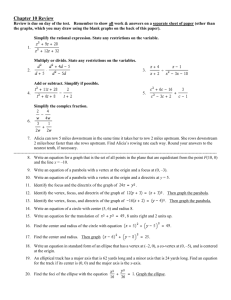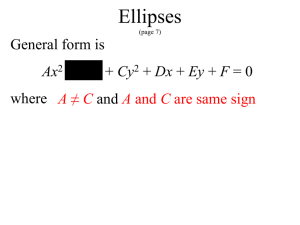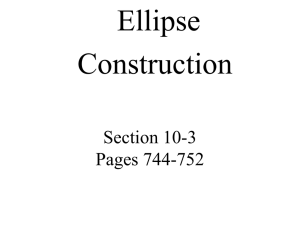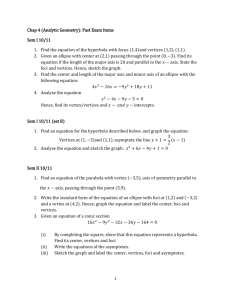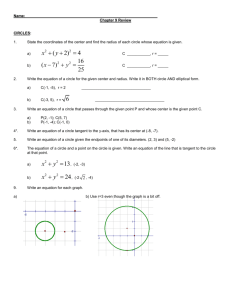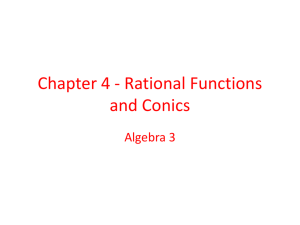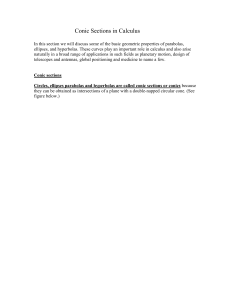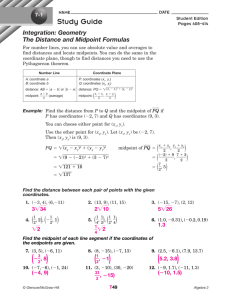10.1 Conics and Calculus
advertisement
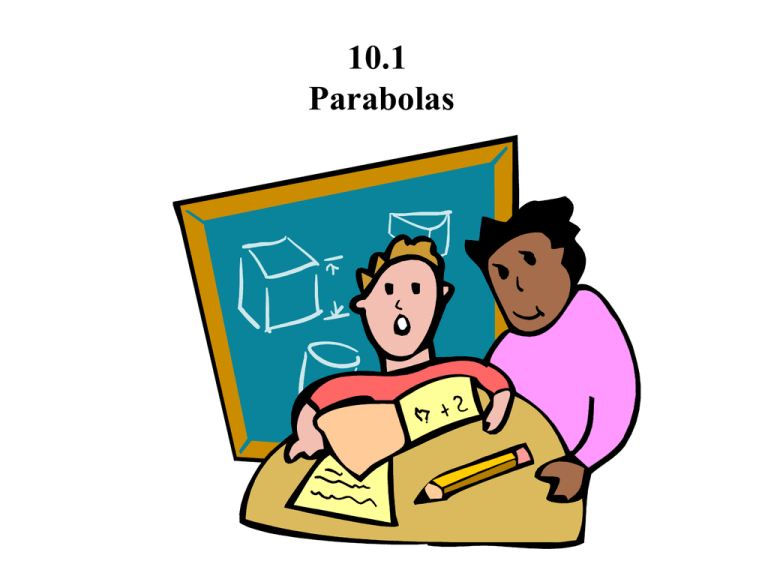
10.1 Parabolas 10.1 Parabolas A parabola is the set of all points (x,y) that are equidistant from a fixed line (directrix) and a fixed point (focus) not on the line. Focus (h, k + p) Vertex (h,k) Directrix y = k - p Standard Equation of a Parabola (x - h)2 = 4p(y - k) Vertical axis Opens up (p is +) or down (p is -) (y - k)2 = 4p(x - h) Horizontal axis Opens right (p is +) or left (p is -) p is the distance from the center to the focus point. Ex. Find the vertex, focus, and directrix of the parabola and sketch its graph. y2 + 4y + 8x - 12 = 0 Now complete the square. y2 + 4y = -8x + 12 y2 + 4y + 4 = -8x + 12 + 4 (y + 2)2 = -8x + 16 (y + 2)2 = -8(x - 2) 4p = -8 p = -2 Write down the vertex and plot it. Then find p. What does the negative p mean? left Directrix x=4 V(2,-2) F(0,-2) Ex. Find the standard form of the equation of the parabola with vertex (2,1) and focus (2,4). First, plot the two points. Which equation will we be using? Vert. or Horz. axis Right, since the axis is vertical, we will be using (x - h)2 = 4p(y - k) What is p? p=3 Now write down the equation. (x - 2)2 = 12(y - 1) Ellipses Ellipses Center point (h,k) Focus point a F V Major axis a2 = b2 + c2 b c F a V Minor axis An ellipse is the set of all points (x,y), the sum of whose distances from two distinct points (foci) is constant. Standard Equation of an Ellipse ( x h) ( y k ) 1 2 2 a b 2 2 ( x h) ( y k ) 1 2 2 b a 2 2 Horz. Major axis Vert. Major axis (h,k) is the center point. The foci lie on the major axis, c units from the center. c is found by c2 = a2 - b2 Major axis has length 2a and minor axis has length 2b. Sketch and find the Vertices, Foci, and Center point. x2 + 4y2 + 6x - 8y + 9 = 0 First, write the equation in standard form. (x2 + 6x + ) + 4(y2 - 2y + ) = -9 (x2 + 6x + 9) + 4(y2 - 2y + 1) = -9 + 9 + 4 (x + 3)2 + 4(y - 1)2 = 4 C (-3,1) ( x 3) ( y 1) 1 4 1 2 2 V (-1,1) (-5,1) c2 = a2 - b2 C (-3,1) c2 = 4 - 1 c 3 Foci are: (3 3,1) & (3 3,1) V (-1,1) (-5,1) Eccentricity e of an ellipse measures the ovalness of the ellipse. e = c/a In the last example, what is the eccentricity? The smaller or closer to 0 that the eccentricity is, the more the ellipse looks like a circle. The closer to 1 the eccentricity is, the more elongated it is. Find the center, vertices, and foci of the ellipse given by 4x2 + y2 - 8x + 4y - 8=0 First, put this equation in standard form. 4(x2 - 2x + 1) + ( y2 + 4y + 4) = 8 + 4 + 4 4(x - 1)2 + (y + 2)2 = 16 x 1 2 4 C( , a= b= c= ) y 2 2 16 1 Vertices ( , ) ( , ) Foci ( , ) ( , ) e= Sketch it. Hyperbolas The standard form with center (h,k) is x h 2 2 y k 2 2 1 a b 2 2 y k x h 1 2 2 a b Note: a is under the positive term. It is not necessarily true that a is bigger than b. Let’s take a look at the first hyperbola form. V(h-a,k) b c b V(h+a,k) C(h,k) F(h-c,k) F(h+c,k) a Note: If c is the distance from the center to F, and all radii of a circle = , then the hyp. of the right triangle is also c. c is the distance from the center to the foci. Therefore, to find c, a2 + b2 = c2 Sketch the hyperbola whose equation is 4x2 - y2 = 16. 4x2 - y2 = 16 2 2 x y 1 4 16 First divide by 16. Write down a, b, c and the center pt. a=2 b=4 Note: a is always under the (+) term. C(0,0) Now find c. c2 5 Let’s sketch the hyperbola. V (2,0) F 2 5 ,0 F V Now, we need to find the equations of the asymptotes. What are their slopes and one point that is on both lines? V F 4 m 2 2 y 0 2( x 0) Sketch the graph of 4x2 - 3y2 + 8x +16 = 0 4(x2 + 2x +1 ) - 3y2 = -16 + 4 4(x + 1)2 - 3y2 = -12 y x 1 1 4 3 2 2 C( , a= b= c= e= Sketch ) Now, divide by -12 and switch the x and y terms. C 1,0 a2 b 3 c 7 7 e 2 V( F( , , )( )( , , V 1,2 F 1, 7 ) ) F V V Eq. of asymptotes. 2 x 1 y0 3 F Classifying a conic from its general equation. Ax2 + Cy2 + Dx + Ey + F = 0 If: A=C 0 AC = 0 , A = 0 or C = 0, but not both AC > 0, A C AC < 0 Both A and C = 0
